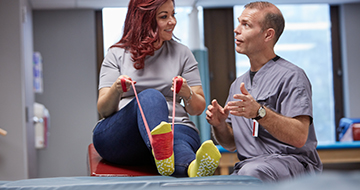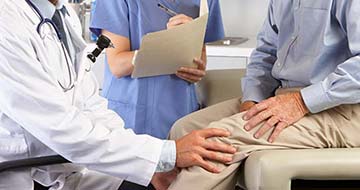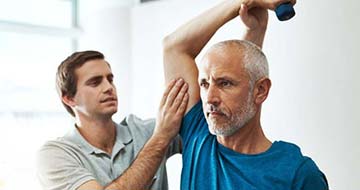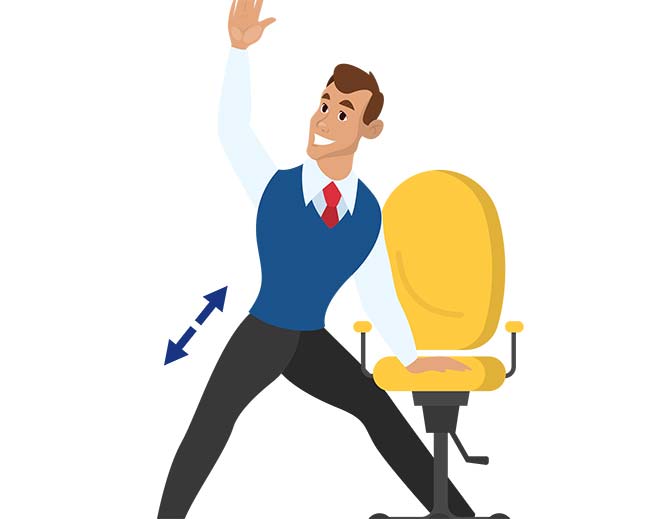Imagine life without pain.
Suffering from joint pain? The orthopedic specialists at Desert Care Network can give you the expert care and treatment you need and help you get back to a more active lifestyle.
We offer a comprehensive array of orthopedic services at our
Palm Springs and La Quinta campus locations as part of our commitment to serve the health needs of communities in the Coachella Valley and its surrounding areas.
Our Institute of Clinical Orthopedics and Neurosciences, our satellite facility
at La Quinta Medical Center, offers the following services:
- Advanced, comprehensive orthopedics care from diagnosis to treatment
- Spine Care Program that incorporates the latest research to help manage or lessen your back and neck pain
- Award-winning Joint Replacement Program with new surgical techniques for replacing hips and knees
- Computerized assessment and treatment for your sports-related injuries, as well as baseline concussion testing
- Orthopedic rehabilitation program to help with your recovery process
The journey from treatment to recovery can be a complicated process. That’s why the orthopedic team of doctors, surgeons, physical therapists and nurses at Desert Care Network and its specialty centers in Palm Springs and La Quinta collaborate to
develop individualized patient care plans with a full continuum of care including diagnosis, treatment, surgery and rehabilitation.
What is Orthopedics?
Orthopedics is a branch of medicine that specializes in the treatment of a variety of injuries and diseases affecting the body's musculoskeletal system. This complex system includes the bones, joints, ligaments, tendons, muscles and nerves.
What Does an Orthopedic Doctor Do?
A professional who specializes in orthopedics is an orthopedist. Orthopedists combine both non-surgical and surgical approaches to treat musculoskeletal issues ranging from sports injuries and joint pain to back problems.
Orthopedists may choose
to specialize in certain areas, such as the foot and ankle, spine, shoulder, hand, hip or knee. They may also focus on one or more of the following branches of orthopedic medicine or subspecialty:
- Musculoskeletal oncology (tumor)
- Pediatric orthopedics
- Sports medicine
- Trauma surgery
- Joint replacement surgery
Orthopedic care can involve a team approach. An orthopedist may work as part of a larger orthopedic treatment team that includes the following:
- Neurologists
- Pain specialists
- Primary doctors
- Psychiatrists
- Chiropractors
Other health professionals that may also be part of the orthopedics team are as follows:
- Physician assistants
- Nurse practitioners
- Occupational and physical therapists
- Athletic trainers
- Counselors
- Social workers
- Vocational workers
Conditions that an Orthopedist Treats
Some of the most common bone and joint conditions that an orthopedist may treat are as follows:
- Fractures – Breaks in the bone
- Nonunions – Failure of fractures to heal
- Malunions – Fractures that heal in a wrong position
- Osteoporosis – A healthy bone looks like a honeycomb when viewed under a microscope. When osteoporosis occurs, the size of these holes and spaces are much larger, causing the bone to lose strength and density and grow thinner.
- Congenital bone diseases – Bone conditions that are evident at, or soon after, birth, mostly caused by factors operating during pregnancy, delivery or early infancy.
- Carpal tunnel syndrome – Condition that occurs when the median nerve, which runs from the forearm into the palm of the hand, becomes compressed as it passes through an opening from the wrist to the hand. This narrow and rigid passageway
of ligament and bones at the base of the hand is called the carpal tunnel. Pain and numbness occur when the lining of irritated tendons or other swelling narrows the tunnel and compresses the median nerve.
- Rheumatoid arthritis – Autoimmune disease that causes pain, swelling, stiffness and loss of functions in the joints. It can also affect the eyes, mouth and lungs.
- Lupus – Autoimmune disease that attacks healthy tissues and affects the skin, joints, kidneys, brain and other organs.
- Bursitis – Inflammation of the cushioning pads around joints
- Chondromalacia patellae – Breakdown of the cartilage in the kneecap
- Gout – Common and painful form of arthritis that happens when uric acid builds up in the body. It occurs when the uric acid turns into needle-like crystals and deposits in the joint.
- Osteoarthritis – The most common form of arthritis that is often related to aging and most frequently occurs in the hands, hips and knees.
- Osteomyelitis – Bone infection caused by bacteria but can also be caused by fungi or other germs.
- Septic arthritis – Condition that develops when bacteria or microorganisms spread through the blood to a joint.
- Tendinitis – Inflammation of the tendon
- Strains or sprains – Injury to the ligaments around a joint due to overstretching
What Are the Symptoms of Knee Pain?
Knee pain can affect people of all ages. It may start suddenly or without warning because of an injury or accident or it may begin as a mild discomfort, then slowly get worse overtime. Persistent or chronic pain is characterized by long-term pain, swelling
or sensitivity in one or both knees.
It is important to note that knee pain may differ from one person to another. Knowing the cause of your knee pain can help you find the right treatment options. If you experience any of the following
symptoms, contact a medical professional or go to an emergency room immediately:
- You cannot bear weight on your knee
- You have severe pain, even when not bearing weight
- Your knee buckles, clicks or locks
- Your knee is deformed or misshaped
- You cannot flex your knee or have trouble straightening it all the way out
- You have a fever, redness or warmth around the knee or a lot of swelling
- You have pain, swelling, numbness, tingling or bluish discoloration in the calf below the sore knee
- You still have pain after three days of home treatment
How Do I Know if my Hip Pain is Serious?
Hip pain is characterized by the pain felt in or around the hip joint, as well as in the groin or thigh areas. Certain injuries or conditions, such as osteoarthritis, can cause hip pain. Although hip pain may go away with rest and pain medication, seek
medical attention if your hip pain is accompanied by any of the following symptoms and conditions:
- Your hip is still painful after one week of resting at home
- You have a fever or rash
- You are diagnosed with sickle cell anemia, a condition that occurs when red blood cells block blood flow to the rest of the body
Diagnosis and Treatment
The orthopedist may ask about the person's symptoms and carry out a physical examination, imaging and blood tests to assess a person's condition. Other various treatment options may be recommended including over-the-counter anti-inflammatory medications,
rehabilitation and physical therapy, home exercise programs, acupuncture, mobility aids and surgery.
Pain doesn’t have to be a part of your routine. Speak with one of our orthopedic specialists at Desert Care Network in our Palm Springs
and La Quinta facilities to learn more about your condition and the treatment suited for your unique needs.












